Study on Reinforcement Technology of Shield Tunnel End and Ground Deformation Law in Shallow Buried Silt Stratum
Abstract
Featured Application
Abstract
1. Introduction
2. Project Overview
3. Numerical Simulation of Tunnel Face Reinforcement Scheme
3.1. Model Setup
3.2. Analysis of Simulation Results for Tunnel Face Reinforcement Schemes
3.2.1. Transverse Soil Deformation at the Tunnel Face
3.2.2. Longitudinal Ground Deformation Characteristics at the Shield Tunnel Launching Section
3.2.3. Analysis of Maximum Ground Deformation
4. Implementation of Shield Tunnel End Reinforcement Scheme
5. On-Site Monitoring and Analysis of Surface Deformation Law
5.1. On-Site Monitoring Data
5.1.1. Monitoring Point Layout
5.1.2. Monitoring Data Analysis
5.2. Analysis and Comparison of Transverse Ground Settlement
5.3. Analysis of Spatiotemporal Evolution Patterns of Ground Settlement
6. Discussion
7. Conclusions
- (1)
- After applying a reinforcement scheme of replacement filling + high-pressure jet grouting piles + overburden counterpressure at the tunnel face, transverse ground deformation during shield tunneling manifested as crown settlement and invert uplift. Scheme II resulted in more uniform and smaller deformations, with a maximum settlement of −26.94 mm and a maximum uplift of 29.83 mm, both within acceptable deformation control limits.
- (2)
- During excavation in the reinforced area, longitudinal ground deformation was mainly concentrated ahead of the shield machine at the crown and invert. Upon reaching the junction between reinforced and unreinforced zones, the settlement zone remained in front of the shield, while uplift was primarily observed at the invert behind the machine within the reinforced area. During excavation in the unreinforced zone, the maximum settlement consistently occurred at the crown of the No. 9 segment ring segment in the rear reinforced area, and the maximum uplift consistently appeared at the invert of the No. 4 segment ring segment. Scheme II provided better control of longitudinal ground deformation.
- (3)
- Throughout the entire shield tunneling process, both maximum settlement and uplift values followed a trend of initial increase, subsequent decrease, and then increase again before stabilizing. Compared to Scheme I, Scheme II yielded lower maximum values for both settlement and uplift, at −26.94 mm and 29.83 mm, respectively. The settlement distribution range was narrower at 20.31 mm, all within the specified deformation control limits.
- (4)
- During the entire tunneling process, the tunnel settlement along the transverse cross-section displayed a typical “V”-shaped distribution, with the greatest ground settlement occurring along the tunnel centerline. Cumulative ground settlement peaked when the shield passed beneath the monitoring point. As the shield approached the boundary between the reinforced and unreinforced zones, settlement values increased slightly but remained within a controlled range and gradually stabilized thereafter.
Author Contributions
Funding
Institutional Review Board Statement
Informed Consent Statement
Data Availability Statement
Acknowledgments
Conflicts of Interest
References
- Wang, Y. Study on Risk Management of Shield Tunnel Construction in Metro Engineering. Master’s Thesis, Beijing Jiaotong University, Beijing, China, 2021. [Google Scholar]
- Li, W.; Li, Z.; Ren, H.; Shi, X.; Zhang, Y. Soil Settlements and Surrounding Structure Failure Mechanism due to Shield Tunneling in Metro Construction. J. Disaster Prev. Mitig. Eng. 2018, 38, 472–479. [Google Scholar]
- Wang, T.; Dai, Z. Application on Ground Reinforcement Method of Launching Shaft for Shield Tunnel. J. Railw. Eng. Soc. 2014, 31, 90–95+100. [Google Scholar]
- Shi, W. Application of high pressure jet grouting pile technology in the reinforcement area of shield end shaft. J. Shijiazhuang Tiedao Univ. Nat. Sci. Ed. 2017, 30 (Suppl. S1), 64–67. [Google Scholar]
- Ding, W.; Liu, K.; Wang, X.; Zhu, J.; Li, S. Reinforcement Optimization of Starting Stratum of Earth-Pressure Balance Shield. J. South China Univ. Technol. Nat. Sci. Ed. 2017, 45, 105–112. [Google Scholar]
- Yang, C.; Gou, X.; Zhao, W.; He, S.; Li, W. Three-dimensional Numerical Analysis of the Impact of Shield Wall Breaking on the Surrounding Environment in Deep Soft Soil Area. Bull. Sci. Technol. 2023, 39, 91–96. [Google Scholar]
- Liu, F.; Cui, J.; Xu, W.; Gao, F. Ground Settlement Characteristics for Launching Section of Shallow Overburden Excavation of Large-diameter Slurry Shield Tunnel. J. Railw. Eng. Soc. 2018, 35, 36–40+69. [Google Scholar]
- Xiao, G.; Lei, B.; Zhan, Y. Numerical Simulation of End Shield Reinforcement Technology in Deep and High Water Pressure Stratum. J. Water Resour. Archit. Eng. 2022, 20, 75–82. [Google Scholar]
- Ma, Q.; Zhang, X.; Shu, H. Innovative Grouting Reinforcement Techniques for Shield Tunnels: A Case Study on Surface Settlement Mitigation. Appl. Sci. 2025, 15, 4623. [Google Scholar] [CrossRef]
- Hong, Z.; Fu, S.; Wu, Y.; Zhang, Y.; Lu, L. Numerical research on the impact of horizontal freezing on existing underground structures in shield reception. Front. Earth Sci. 2024, 12, 1511744. [Google Scholar] [CrossRef]
- Mooney, M.A.; Grasmick, J.; Kenneally, B.; Fang, Y. The role of slurry TBM parameters on ground deformation: Field results and computational modelling. Tunn. Undergr. Space Technol. 2016, 57, 257–264. [Google Scholar] [CrossRef]
- Peck, R.B. Deep excavations and tunneling in soft ground. In Proceedings of the Seventh International Conference on Soil Mechanics and Foundation Engineering, Mexico City, Mexico, 25–29 August 1969; pp. 225–281. [Google Scholar]
- Lu, S.; Wang, W.; Xiao, L. Evaluation of Soil Structure Characteristics of Wenzhou Soft Clay and Analysis of Tunnelling Disturbance with Tunnel Boring Machines. Ind. Constr. 2023, 53, 1–10+20. [Google Scholar]
- Sun, M. Study on the Combined Reinforcement of Silt Stratum in Large Longitudinal Slope Shield Tunnel. Railw. Constr. Technol. 2024, 12, 194–198. [Google Scholar]
- Wang, T.; Zhao, Q. Research on Tunnel Entrance Construction Technology under the Geological Condition of Silt in Shallow Buried Gully. Mod. Tunn. Technol. 2024, 61 (Suppl. S1), 1039–1046. [Google Scholar]
- Jin, H.; Yuan, D.; Wang, E. Experimental investigation on shield-soil interaction during shield posture adjustment in soft ground. Tunn. Undergr. Space Technol. 2025, 158, 106386. [Google Scholar] [CrossRef]
- Gao, F.; Li, Z.; Yang, K.; Chen, Y.; Bian, X. Shield tunneling-induced disturbance in soft soil. Transp. Geotech. 2023, 40, 100971. [Google Scholar] [CrossRef]
- Imteyaz, W.; Mishra, S. Stability Analysis of the Shallow Tunnel Under Soft Ground Regime. Mater. Today Proc. 2023, 87, 152–158. [Google Scholar] [CrossRef]
- Bao, X.; Wang, S.; Li, W.; Zhang, W.; Wu, N. Analysis of Excavation Stability of Backfill Soil Large Span Super Shallow Buried Metro Tunnel. Sci. Technol. Eng. 2022, 22, 3342–3348. [Google Scholar]
- Wang, X.; Zhou, S.; Chi, J.; Wu, X. Study on Shallow-buried Tunnel’s Thickness-span Ratio in Upper-soft Lower-hard Ground. Chin. J. Undergr. Space Eng. 2011, 7, 700–705. [Google Scholar]
- GB 50911-2013; Technical Code for Monitoring in Urban Rail Transit Projects. China Architecture & Building Press: Beijing, China, 2013.
- Ding, W.; Huang, X.; Dai, Z.; Wang, C.; Wang, Z.; Yu, W. Analysis of the Collapse Mechanism and Stabilization Optimization of the Composite Stratum at the Boundary between Prereinforced and Unreinforced Areas near a Shield Launching Area. Int. J. Geomech. 2023, 23, 05023002. [Google Scholar] [CrossRef]
- Wu, Q. Study on Construction Safety Risks Control Technology for Tunneling Adjacent to Existing Buildings (Structures) Within Shield Launching/Arriving Section. Ph.D. Thesis, Beijing Jiaotong University, Beijing, China, 2020. [Google Scholar]
- Wang, L.; Zhong, J.; Zhu, B. Numerical Analysis on Ground Settlement Induced by Shield Tunnelling with Adjacent End Shaft Works. Mod. Tunn. Technol. 2022, 59, 124–132. [Google Scholar]
- Chen, Y.; Li, X.; Chen, S. Prediction of Surface Settlement Caused by Shield Construction in Tunnel Based on Peck Formula. Saf. Environ. Eng. 2023, 30, 79–83+91. [Google Scholar]
- Huang, L. Correction and Application of Peck Formula in Shield Tunnel of Silty Clay Layer. J. Lanzhou Inst. Technol. 2019, 26, 23–28+68. [Google Scholar]


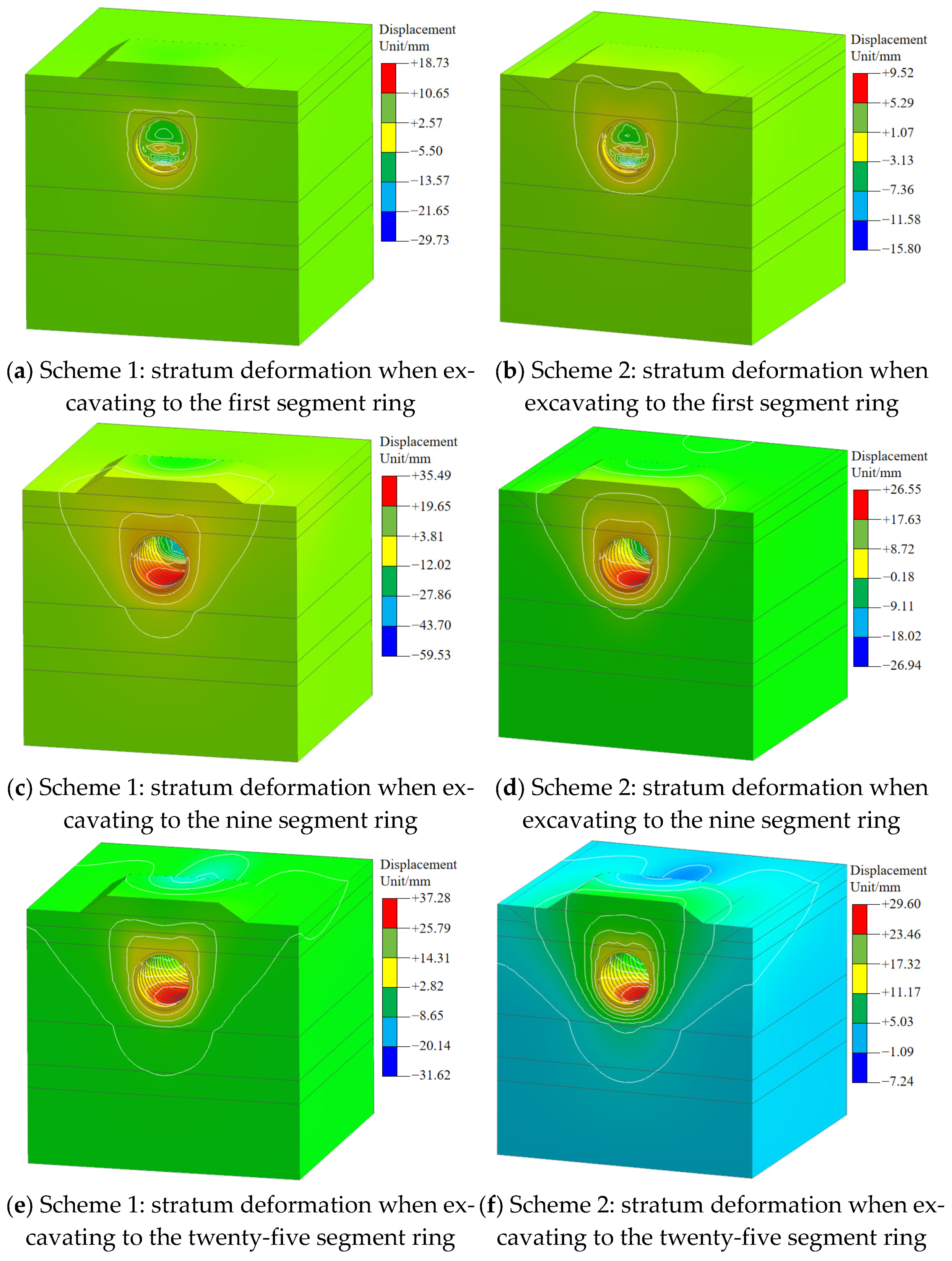
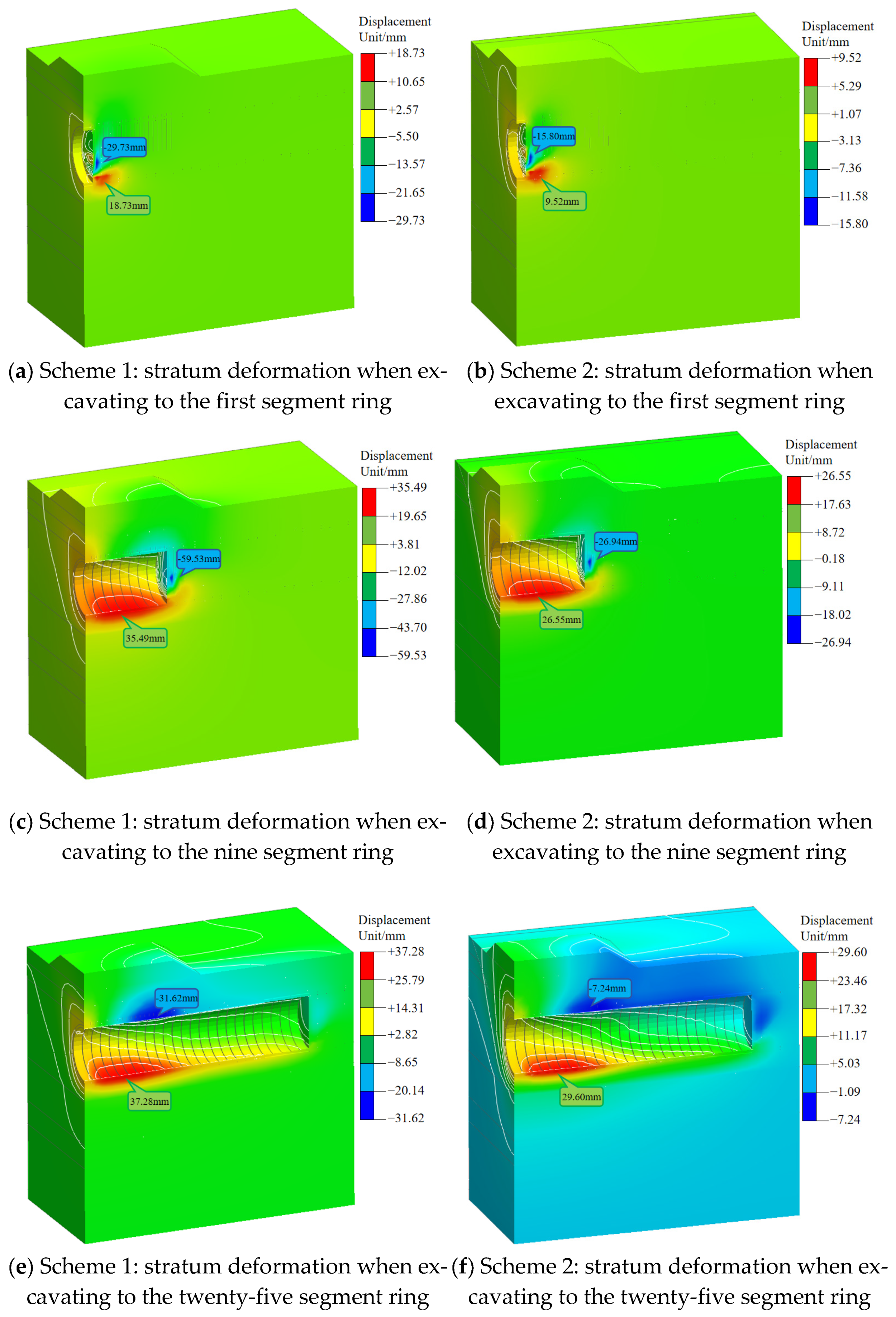
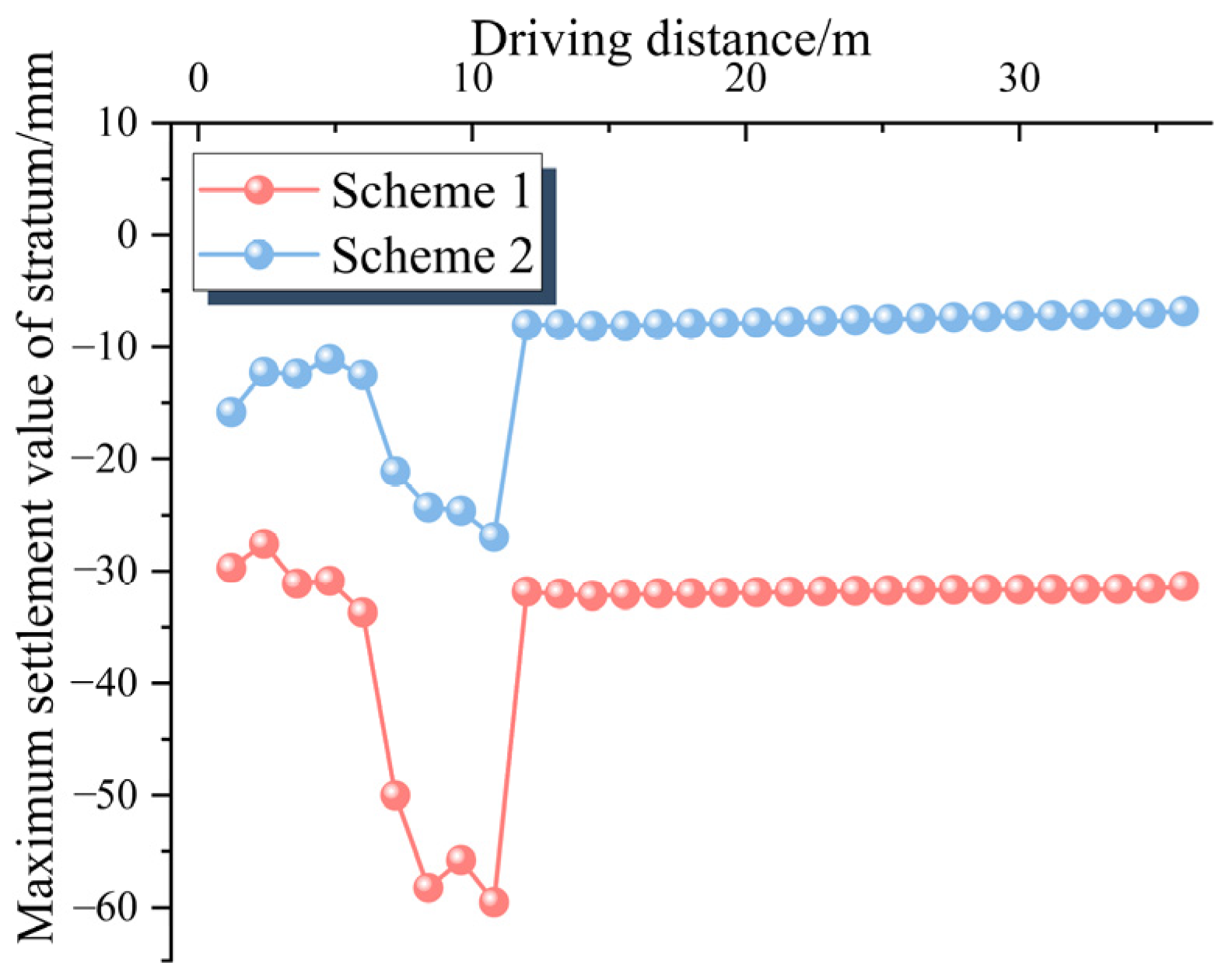
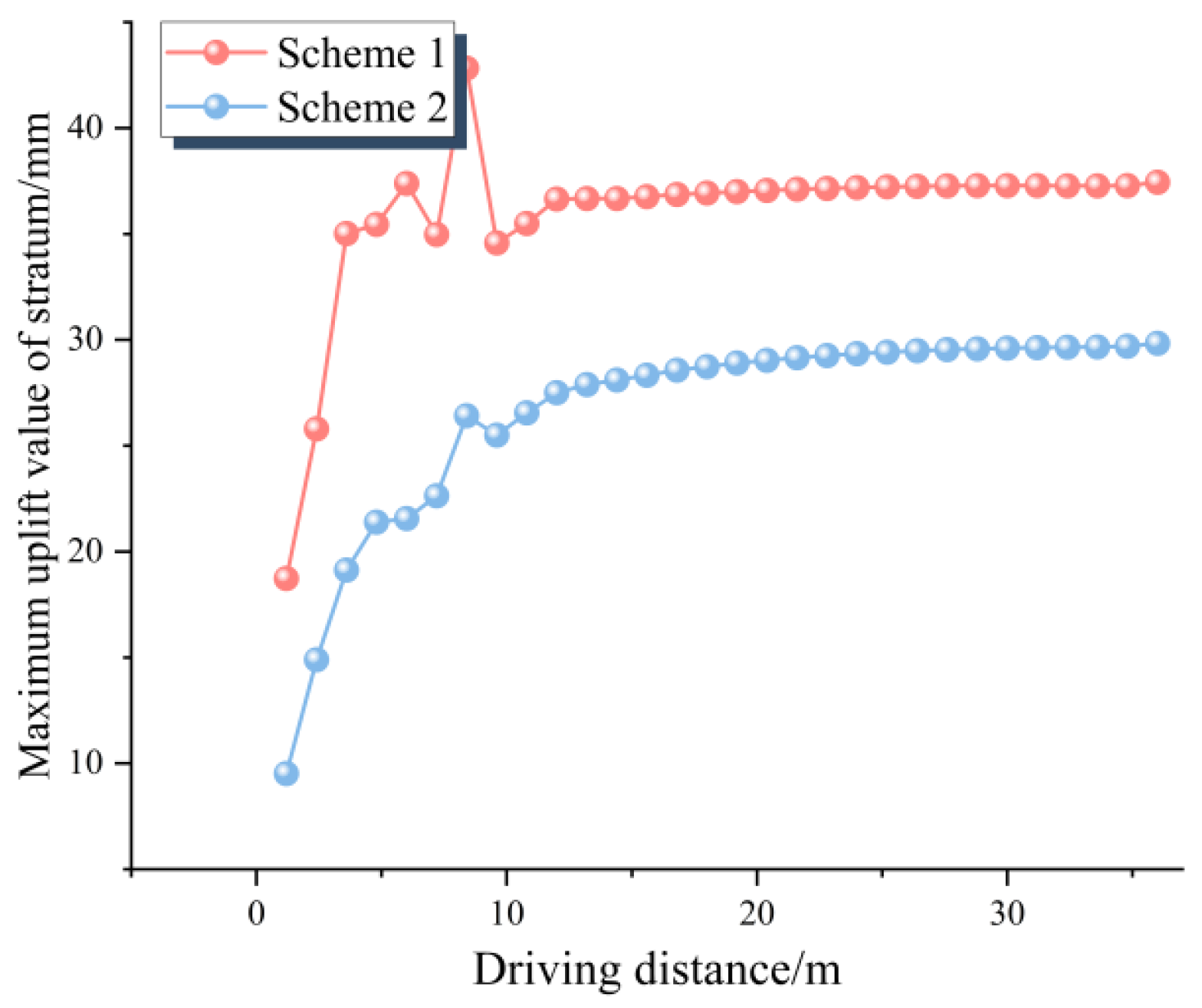



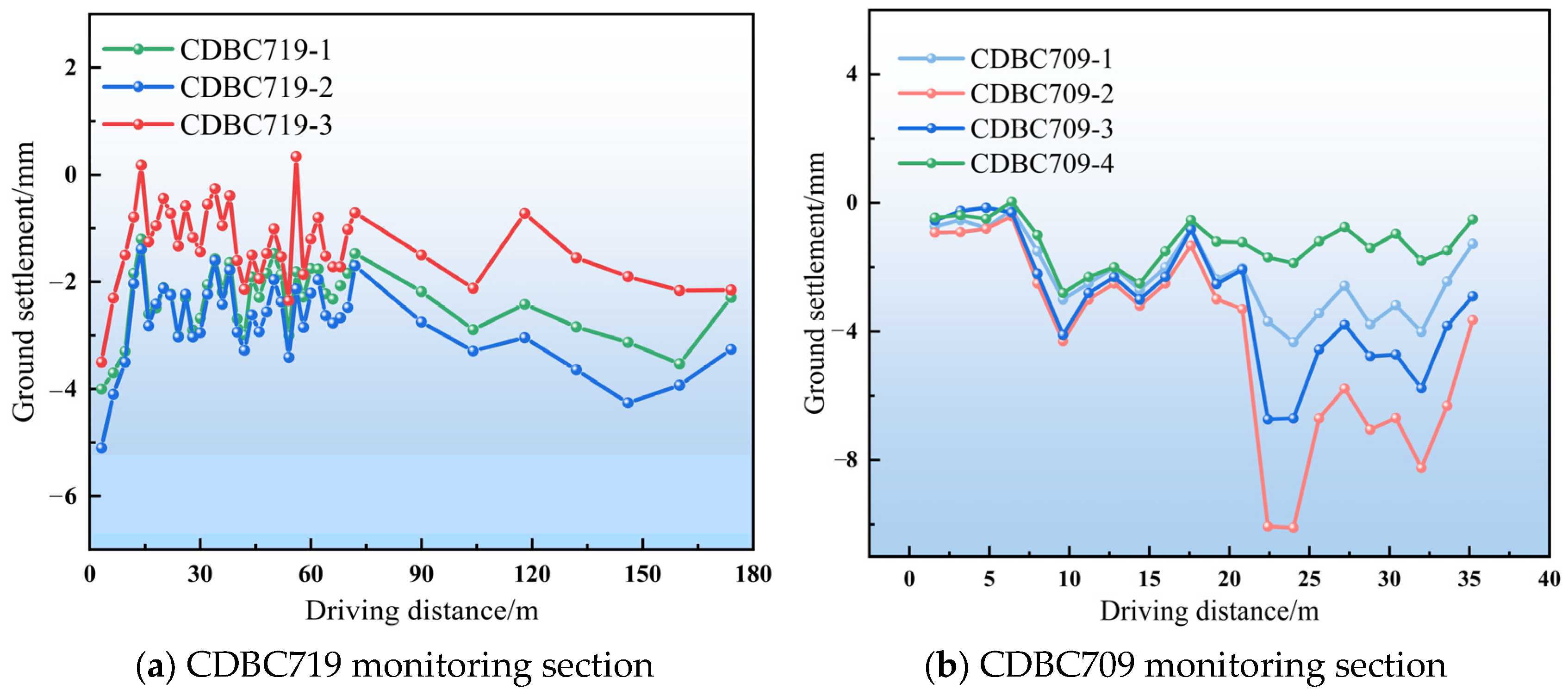
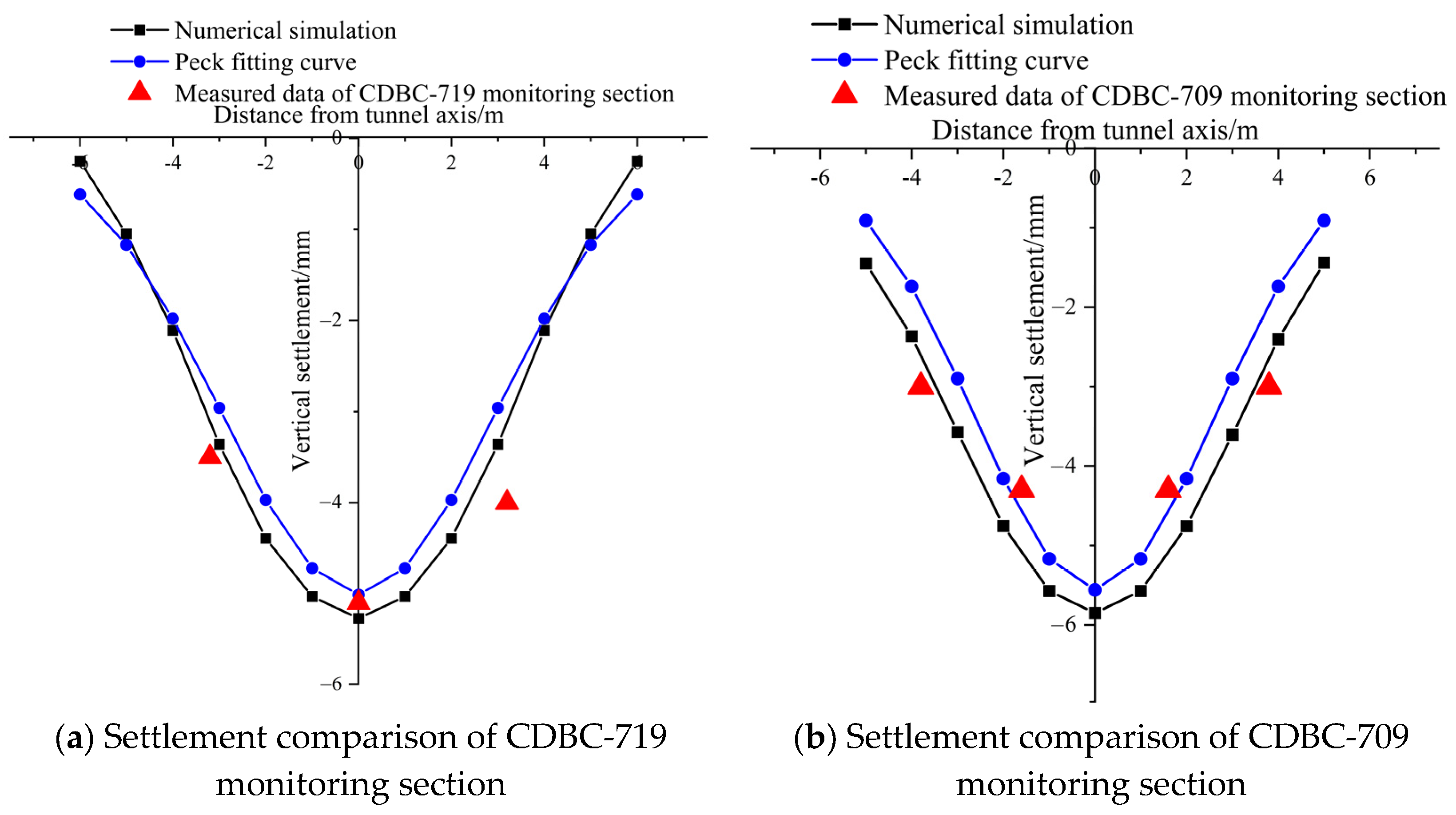
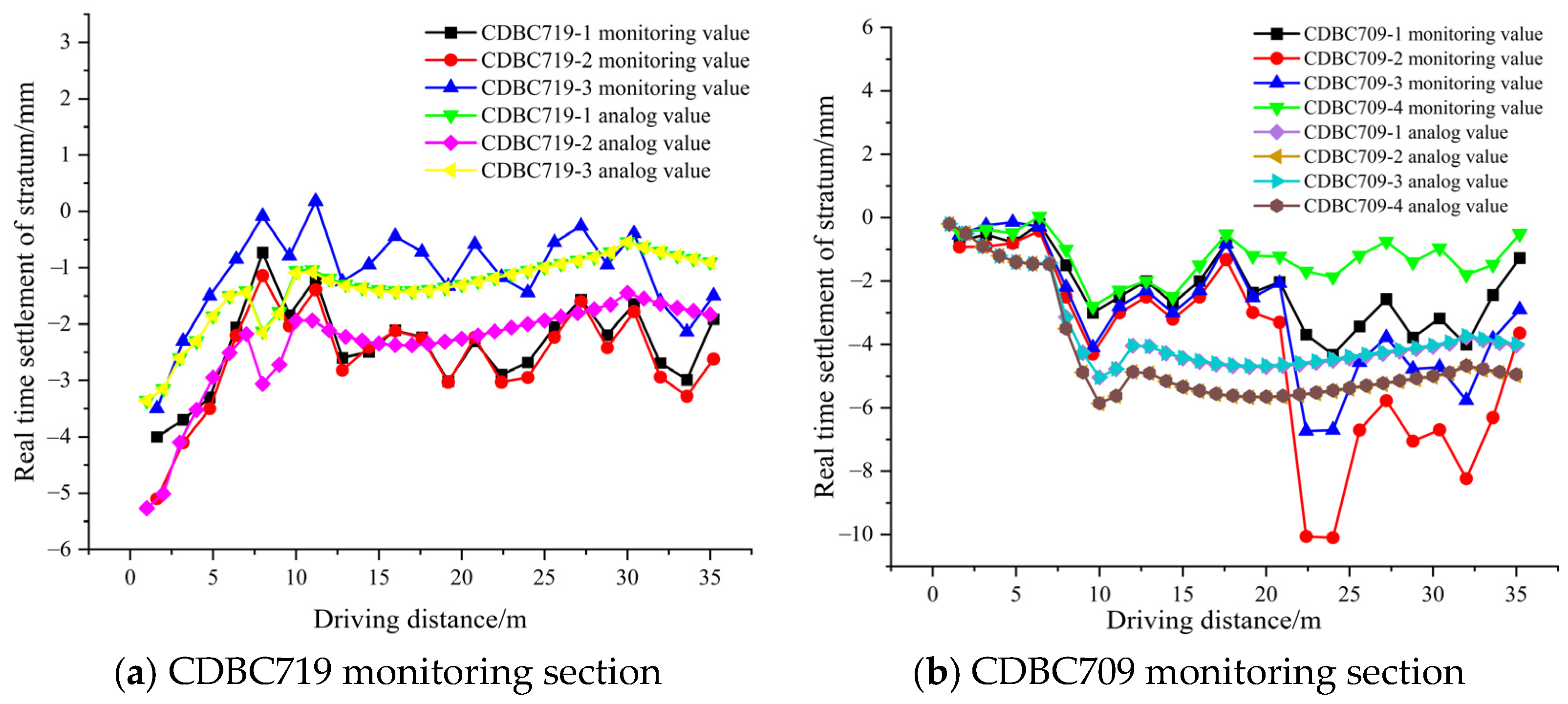
| Ground Level | Soil Layer Name | Intensity/(g/cm3) | Water Content/% | Void Ratio/% | Modulus of Compressibility/MPa | Deformation Modulus/MPa | Permeability Coefficient/(m/d) | Cohesion/KPa | Internal Friction Angle/° |
|---|---|---|---|---|---|---|---|---|---|
| <1> | Miscellaneous fill | 2.02 | 32.2 | 62.2 | 4.38 | 10 | 0.1~2 | 15.0 | 12.0 |
| <2-1A> | Mucky soil | 1.54 | 73.8 | 199.4 | 1.89 | 2 | 0.001 | 6.0 | 4.0 |
| <4N-2> | Silty clay | 1.99 | 25.5 | 72.2 | 5.17 | 12 | 0.050 | 19.2 | 12.6 |
| <6> | Completely weathered coarse sandstone | 2.03 | 20.0 | 60.5 | 5.47 | 60 | 0.400 | 26.0 | 20.0 |
| <7-1> | Strongly weathered coarse sandstone | 2.06 | 15.1 | 50.6 | 5.81 | 90 | 0.600 | 35.0 | 25.0 |
| <8-1> | Moderately weathered coarse sandstone | 2.57 | 13.6 | 60.3 | 5.91 | 92 | 0.900 | 250.0 | 28.0 |
| Material | Elastic Modulus/MPa | Poisson’s Ratio |
|---|---|---|
| Segment | 35,000 | 0.2 |
| Shield shell | 208,000 | 0.31 |
| Jet grouting pile | 30.9 | 0.3 |
Disclaimer/Publisher’s Note: The statements, opinions and data contained in all publications are solely those of the individual author(s) and contributor(s) and not of MDPI and/or the editor(s). MDPI and/or the editor(s) disclaim responsibility for any injury to people or property resulting from any ideas, methods, instructions or products referred to in the content. |
© 2025 by the authors. Licensee MDPI, Basel, Switzerland. This article is an open access article distributed under the terms and conditions of the Creative Commons Attribution (CC BY) license (https://creativecommons.org/licenses/by/4.0/).
Share and Cite
Zhang, J.; Bao, X. Study on Reinforcement Technology of Shield Tunnel End and Ground Deformation Law in Shallow Buried Silt Stratum. Appl. Sci. 2025, 15, 7657. https://doi.org/10.3390/app15147657
Zhang J, Bao X. Study on Reinforcement Technology of Shield Tunnel End and Ground Deformation Law in Shallow Buried Silt Stratum. Applied Sciences. 2025; 15(14):7657. https://doi.org/10.3390/app15147657
Chicago/Turabian StyleZhang, Jia, and Xiankai Bao. 2025. "Study on Reinforcement Technology of Shield Tunnel End and Ground Deformation Law in Shallow Buried Silt Stratum" Applied Sciences 15, no. 14: 7657. https://doi.org/10.3390/app15147657
APA StyleZhang, J., & Bao, X. (2025). Study on Reinforcement Technology of Shield Tunnel End and Ground Deformation Law in Shallow Buried Silt Stratum. Applied Sciences, 15(14), 7657. https://doi.org/10.3390/app15147657





